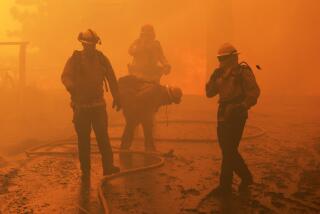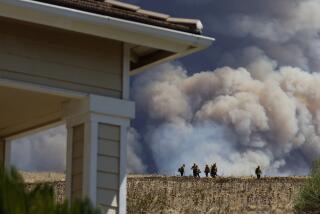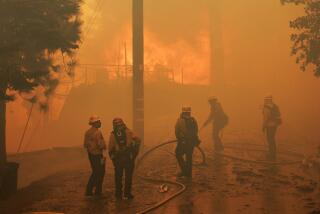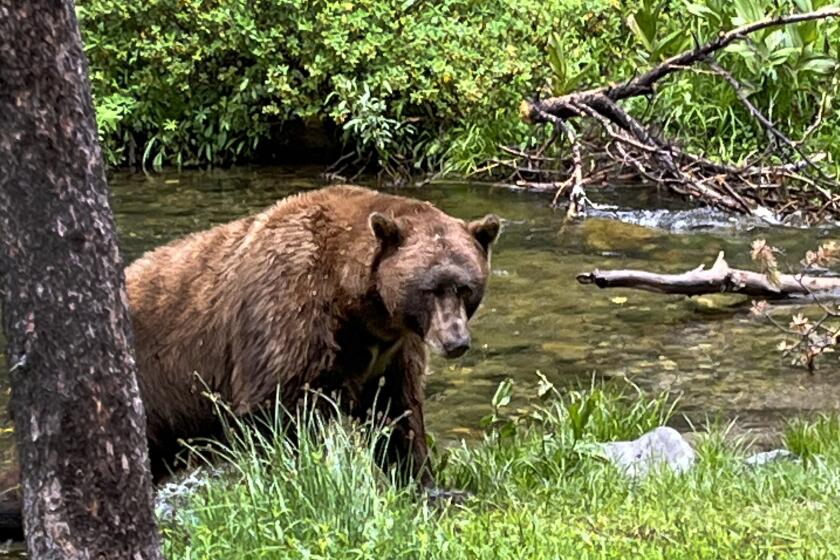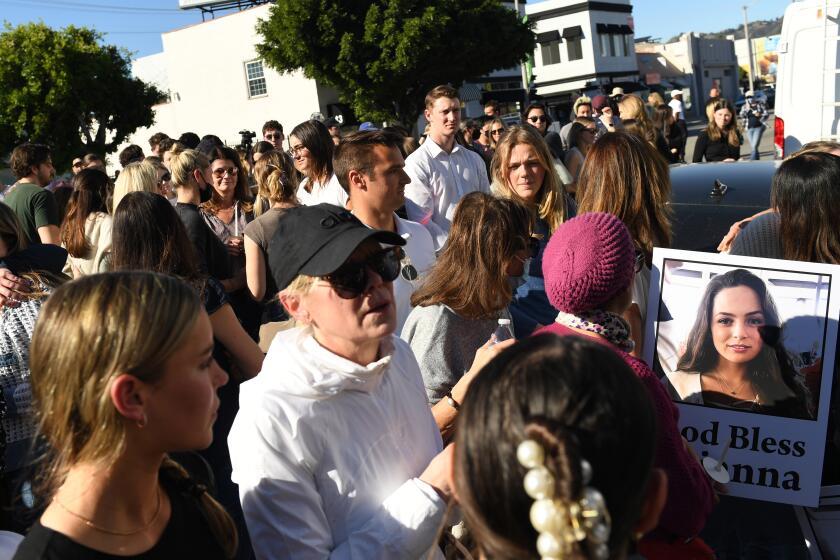Airborne Traffic Reporter Bruce Wayne Dies in Crash
Bruce Wayne, the airborne traffic reporter who for 18 years guided millions of motorists through Southern California traffic snarls, was killed Wednesday morning when his plane crashed shortly after takeoff from Fullerton Municipal Airport.
Wayne’s wife arrived at the accident site soon after the plane went down and calmly broadcast details of the crash.
The 52-year-old Wayne had just lifted off from the runway en route to his familiar perch above the freeways for radio stations KFI and KOST when, according to a witness, his blue and white Cessna Cardinal seemed to develop engine trouble at an altitude of about 300 to 500 feet.
A city employee working at the single-runway airfield told airport manager Rod Murphy that the plane’s engine appeared to be backfiring or missing.
“When he looked up, the plane was in a tight left turn. Moments later there was a big explosion,” Murphy said.
The single-engine plane slammed into an empty tractor-trailer rig parked behind a wholesale food warehouse half a mile east of the airport, exploding in a ball of fire on impact. No one on the ground was injured in the 6:18 a.m. crash.
As officials of the two radio stations became aware that Wayne had not been heard from--and that a plane was down at Fullerton--word of the accident was broadcast throughout Southern California. Eventually, KFI scrapped its regular programming and devoted its daytime hours to news accounts from the scene and tributes to the popular traffic reporter.
Several of the reports came from Wayne’s wife of 21 years, Lois, who had been called at home by KFI.
Driven to the crash scene six miles from their home by a neighbor, Lois Wayne spent more than two hours calmly doing news reports about the accident and interviews on KFI.
No Number
“I am at the crash site of a (Cessna) Cardinal,” Lois Wayne said, as her first interview was broadcast live. “There is no paint or a number on the aircraft. The aircraft did have an explosion on impact.”
Although officials were not immediately certain that the wreckage was of her husband’s plane, Lois Wayne said she knew right away that it was.
She later told reporters at the scene that her husband “was only two weeks from achieving his dream of surviving 25 years as an airborne traffic reporter. . . .”
“It meant everything to him, and he worked very hard to be able to keep doing it,” Lois Wayne said. “He always kept himself in good physical shape, so he wouldn’t have any problem renewing his license.
“He lived with this for 25 years, and we often talked about the dangers involved. It’s just something everybody lives with.”
Only hours later, after most of the reporters had left the crash scene, did the pilot’s wife allow her emotions and grief to show.
“We always lived in the knowledge that something like this could happen,” she said, tears brimming in her eyes. “But that’s just part of the territory.”
Recited Prayers
After authorities had placed her husband’s charred remains in a body bag and placed it on a stretcher, Lois Wayne knelt beside it, touched the bag and recited “the ‘Lord’s Prayer’ and my own personal prayer,” she said.
Just Tuesday night, Wayne experienced a close call in the air, his wife said, when another plane swerved in front of him as he was preparing to land at Fullerton, after finishing his two-hour evening tour above the freeways.
“He was quite white when he came in the house and said, ‘See, this is what it’s like,’ ” she said.
KFI also took calls from listeners, who flooded the station’s telephone lines Wednesday with testimonies of what the airborne traffic scout had meant to them.
A listener named Gary said in a near whisper: “There’s going to be an empty spot in my car now.”
Along with mourning Wayne’s loss, callers also praised Lois Wayne for what they called her “courage” in accepting the tragedy publicly and thus helping the rest of his listeners grasp the death.
Radio Interview
“You are a trooper,” one KFI reporter told the widow during an early morning interview on the air. “Bruce would be proud.”
During the day, KFI frequently played Wayne’s final “KFI in the Sky” traffic bulletin, which he gave three minutes before his plane crashed. The last thing heard on the tape is Wayne’s hearty laughter, which a fellow radio reporter told listeners “was almost his trademark.”
Born in Manchester, N.H., Wayne had nine years’ experience in radio and television (and flying lessons courtesy of the GI Bill), when he became Boston’s first flying traffic reporter in 1961. At the time, he said in a Times interview earlier this year, “I had never even heard an air traffic report.”
According to Lois Wayne, who is writing a book about the history of the nation’s flying traffic reporters, her husband was among the first in the nation. The first was Capt. Max Schumacher who began in 1958 for KABC radio in Los Angeles and was killed in a 1966 midair collision.
U-2 Pilot Powers Killed
Wayne was the third Southern California airborne reporter to die in a fiery crash in the past 20 years. In the 1966 accident, Schumacher and four other people were killed when his KMPC helicopter collided with a police helicopter, spewing burning metal for a half mile over Dodger Stadium. In 1977, Francis Gary Powers, the former U-2 spy plane pilot who had been shot down over the Soviet Union, died when his KNBC helicopter crashed in an Encino field, after apparently running out of fuel.
Whether Wayne, a veteran pilot with more than 30,000 hours of flying, was trying to return to the airport or reach a nearby large field for an emergency landing Wednesday morning is “only speculation at this point,” said Murphy, the airport director.
“That was probably his intent, but we’re only second-guessing. He would have been very concerned and doing what would be expected, which is find an open area or try to get back to the field,” he said.
The crash destruction was so extensive that it took seven hours to positively establish through dental and other medical records that it was Wayne who had died in the wreckage. The largest recognizable fragment of the aircraft was the engine, which came to rest a few feet beyond where the plane had torn through one side of the trailer and out the other.
Compression Loss
Although a preliminary investigation by the National Transportation Safety Board showed that there was a compression loss in one of the engine’s four cylinders, that would not be enough to cause the plane crash, according to Gary Mucho, head of the NTSB’s Los Angeles office. There did not appear to be any problem with fuel contamination, he said.
Lois Wayne said she had her first inkling that something was wrong when KFI news director David Blake called her at 6:40 Wednesday morning and said the station had not heard from Wayne for 20 minutes and was having trouble contacting him.
“And then I knew,” Lois Wayne told a reporter. “If there’s anything I could say about Bruce at this moment, it’s that he is extremely dependable. Had he been all right, he would have called.”
Wayne set up San Bernardino radio station KRNO’s first flying traffic reporting service in 1968, after he moved to California. He had been a pilot-traffic reporter for KFI since May, 1970. As part of the KFI news team, Wayne helped the station win several reporting awards over the years for its coverage of floods, fires and other natural disasters.
Although he always took his flying and reporting seriously, the affable Wayne was not without his whimsical touch, as evidenced when, after moving to California, he changed his real name, Bruce Talford, to Bruce Wayne, which was the “secret identity” of the title character in the “Batman” comic and television series. His wife also adopted it.
‘Caped Crusader’
“Talford is not really a good radio name,” he explained earlier this year. “The ‘Batman’ TV show was highly popular, and I thought I could have a lot of fun with that, being a ‘flying caped crusader.’ ”
Until Wednesday morning, Wayne could boast of never having had an accident as a pilot. He was involved in a helicopter crash--as a passenger--while covering traffic in Boston in 1964.
Wayne, who had broken his leg skiing, was flying with a substitute pilot, who lost control of the aircraft 50 feet in the air and 200 feet out over Boston Harbor. Wayne was forced to swim 200 feet to shore with a full-length cast on his leg.
He is survived by two children, a son, 26, and a daughter, 29, by a previous marriage. Funeral arrangements are pending.
As a tribute to Wayne, KFI asked listeners to turn on their vehicles’ headlights.
Times staff writers Nancy Wride, Dennis McLellan, Bob Schwartz and Maria L. LaGanga contributed to this report.
More to Read
Sign up for Essential California
The most important California stories and recommendations in your inbox every morning.
You may occasionally receive promotional content from the Los Angeles Times.
